Walter ppq navy
Probably no one will be surprised by the fact that weaponused strictly on land, and that used near the sea should be different. We are not talking about versions of pistols and machine guns capable of firing in the aquatic environment, but about ordinary weapons adapted for firing in the air, but being in close contact with seawater, which means that they cannot be excluded inside the weapon. Let's try to figure out exactly how such a weapon differs from ordinary samples on the example of a Walter PPQ Navy pistol, which appeared relatively recently, but has already established itself as a reliable, durable and effective weapon.
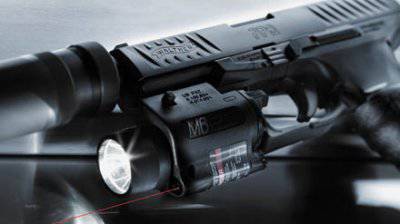 First of all, you need to remember that sea water contains a sufficiently large amount of salts dissolved in it, which makes it especially destructive for parts of weapons. Actually, it’s not necessary to go into details here, every car enthusiast knows how salt can quickly ruin the car body, in the case of firearms the situation is no better. Of course, regular cleaning and lubrication would almost completely compensate for the harmful effects of sea water on the weapon, but cleaning the weapon completely after each accidental washing will fall off its hands, so the solution to this problem lies on the shoulders of the manufacturer, not the consumer. Unfortunately, the “classic” surface coatings of parts cannot provide protection against salt water, therefore, those methods that were suitable for coating parts in previous generations of РХNUMX pistols in this case are not suitable. The way out of this situation was the process of teniferization, which is a completely domestic development of D. A. Prokoshkina dated 99 year, but widely used by various foreign companies, not only armory, and positioned as unique and actually open. However, in the case of the PPQ Navy pistol, this technology was indeed improved. The fact is that the very essence of the teniffering procedure is that the part is immersed in salt molten at a high temperature. In the process, a film is formed on the surface of the part that is resistant to abrasion and completely protects the part from the effects of corrosive media, such as sea water. But this part processing process has a negative side in the form of the fact that the surface of the part becomes rough, and if it is back polished, the integrity of the protective coating can be broken. The solution to this problem was the subsequent oxidation of parts, which created another protective layer, after which there was a polishing on a new layer and partly on the first layer, and then after the reverse oxidation. This ensured full coverage of the part with a protective layer that even with sufficiently long life protects the part.
First of all, you need to remember that sea water contains a sufficiently large amount of salts dissolved in it, which makes it especially destructive for parts of weapons. Actually, it’s not necessary to go into details here, every car enthusiast knows how salt can quickly ruin the car body, in the case of firearms the situation is no better. Of course, regular cleaning and lubrication would almost completely compensate for the harmful effects of sea water on the weapon, but cleaning the weapon completely after each accidental washing will fall off its hands, so the solution to this problem lies on the shoulders of the manufacturer, not the consumer. Unfortunately, the “classic” surface coatings of parts cannot provide protection against salt water, therefore, those methods that were suitable for coating parts in previous generations of РХNUMX pistols in this case are not suitable. The way out of this situation was the process of teniferization, which is a completely domestic development of D. A. Prokoshkina dated 99 year, but widely used by various foreign companies, not only armory, and positioned as unique and actually open. However, in the case of the PPQ Navy pistol, this technology was indeed improved. The fact is that the very essence of the teniffering procedure is that the part is immersed in salt molten at a high temperature. In the process, a film is formed on the surface of the part that is resistant to abrasion and completely protects the part from the effects of corrosive media, such as sea water. But this part processing process has a negative side in the form of the fact that the surface of the part becomes rough, and if it is back polished, the integrity of the protective coating can be broken. The solution to this problem was the subsequent oxidation of parts, which created another protective layer, after which there was a polishing on a new layer and partly on the first layer, and then after the reverse oxidation. This ensured full coverage of the part with a protective layer that even with sufficiently long life protects the part.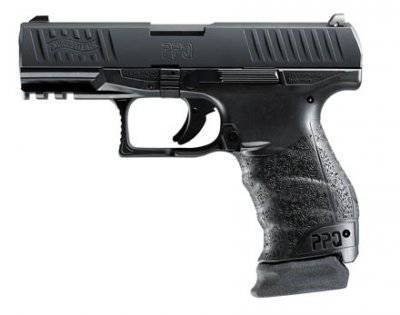 But not only salts dissolved in water are destructive for weapons, the design of the pistol itself is somewhat different in details from weapons for sushi, although once again I remind you that the pistol itself is not suitable for shooting under water. Rather, it is possible that it can fire a weapon, but ordinary cartridges, or rather their bullets, are not adapted for a normal “flight” in the water — in an environment with a density many times greater than the air one. Despite the simplicity of the device weapons, and in it, in most cases, everything is really simple, individual nodes can not work normally after water procedures. So, for example, in a PPQ Navy pistol, the drummer moves along a channel in the gate, but if this channel is filled with water, the movement of the drummer will be significantly hampered. To solve such a problem, a separate hole is provided in the gate, into which water will be displaced when the drummer moves and, as a result, there will not be a situation when the drummer’s strength is not enough for a normal cap. The spring itself has the most necessary rigidity to overcome the water resistance in the gate channel by the drummer. A similar solution to the problem is used in such well-known pistols as Glock. Thus, the gun, even lain for several days in the water, can be removed and immediately applied, without waiting for the water to flow out of the weapon, and even more so to clean and dry it. It may be foolish for someone that such a weapon exists at all, since not to wet a pistol may seem like a perfectly accomplished task. However, even with all the efforts on the part of the person owning such weapons, such situations cannot be ruled out. Still, people trust their life with these weapons and there is simply no right to let them down at the gun.
But not only salts dissolved in water are destructive for weapons, the design of the pistol itself is somewhat different in details from weapons for sushi, although once again I remind you that the pistol itself is not suitable for shooting under water. Rather, it is possible that it can fire a weapon, but ordinary cartridges, or rather their bullets, are not adapted for a normal “flight” in the water — in an environment with a density many times greater than the air one. Despite the simplicity of the device weapons, and in it, in most cases, everything is really simple, individual nodes can not work normally after water procedures. So, for example, in a PPQ Navy pistol, the drummer moves along a channel in the gate, but if this channel is filled with water, the movement of the drummer will be significantly hampered. To solve such a problem, a separate hole is provided in the gate, into which water will be displaced when the drummer moves and, as a result, there will not be a situation when the drummer’s strength is not enough for a normal cap. The spring itself has the most necessary rigidity to overcome the water resistance in the gate channel by the drummer. A similar solution to the problem is used in such well-known pistols as Glock. Thus, the gun, even lain for several days in the water, can be removed and immediately applied, without waiting for the water to flow out of the weapon, and even more so to clean and dry it. It may be foolish for someone that such a weapon exists at all, since not to wet a pistol may seem like a perfectly accomplished task. However, even with all the efforts on the part of the person owning such weapons, such situations cannot be ruled out. Still, people trust their life with these weapons and there is simply no right to let them down at the gun. The appearance of the PPQ Navy pistol is very similar to previous models of weapons. At least, the silhouette of the pistol has remained practically unchanged, but there are some innovations, therefore, one cannot do without a description. First of all, it is worth noting the surface of the weapon handle, which virtually completely excludes the possibility of the pistol sliding in the shooter's palm, regardless of whether there is water or a layer of silt between the handle and the palm. At the same time, the handle retained the ability to install the rear parts of various sizes, which allows the weapon to fit the size of the shooter's palm. Of the safety devices, there is only a double trigger, which is quite enough provided that the weapon is equipped with a firing mechanism with a pre-cocked firing pin, although the non-automatic safety switch would look very good on both sides of the weapon. Of the weapon controls, there is only a trigger, a long slide stop lever, and a magazine release button, as well as a slider for disassembling the weapon. There are wide and deep notches on the casing-bolt, which allow you to confidently pull the bolt back even if he or the shooter's hands are soiled with something slippery. Sights are open, consist of a rear sight and a front sight, marked with light-accumulating paint. An interesting point is that the weapon can be equipped with two versions of the barrels, one of which has a thread for installing a silent firing device, but in the case when it is removed, the thread is closed with a protective cap. It is also interesting that the silent firing device itself is manufactured by another company - Brügger & Thomet AG, while earlier everything was produced only by Walther. Under the barrel of the weapon on the frame there is a seat for mounting a compact flashlight or a laser designator, although many dispute the need for these devices in weapons, referring to the fact that with the same laser designator, the shooter is guided only by the laser target spot, which may not be visible due to those or other reasons that may result in a delay before firing.
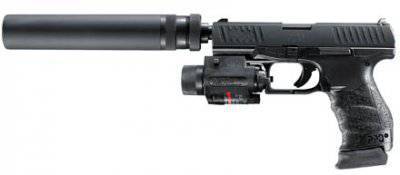 Automatic pistol built on the principle of work with a short stroke of the weapon, while the barrel enters into engagement with the casing-bolt through the protrusion above the chamber and the window for ejection of spent cartridges. The whole system works as follows. When you press the trigger happens dovzvod drummer pistol, and after its failure. After hitting the primer, the initiating composition ignites, and after that the powder, which leads to the formation of a large amount of powder gases, which pressurize with their increasing volume. Since the cartridge is in the barrel of the gun, the powder gases simply have no place to go and they seek to increase the distance between the cartridge case and the bullet in order to free up more volume for themselves. Thus, the powder gases with the same force push the bullet forward along the barrel, and the sleeve back towards the arrow. But the bottom of the sleeve rests on the bolt pistol, which in turn is connected to the barrel through a window for ejection of spent cartridges and a projection above the chamber. Given that the weight of the bullet is significantly less than that of this whole structure, it leaves the barrel before the automatic weapon of the weapon begins to move. The movement of the moving elements in this case does not ensure that the powder gases press the sleeve, forcing it to push the slide back, but that the pulse is transmitted through the sleeve to the slide, so the sleeve does not push the slide, but the slide from the cartridge chamber. So, after a shot, the barrel and bolt begin to move backwards, while under the barrel chamber there is a protrusion with a figured notch into which the pin passes through the frame of the weapon. This cut is made so that when it moves backwards, it interacts with the pin and causes the breech to fall. This leads to the fact that the protrusion above the chamber of the weapon leaves the clutch with the casing-bolt and the bolt is already moving alone, without a barrel. Removing the cartridge case and throwing it out, the cover-shutter reaches its rearmost point and stops for a split second. Under the influence of the return spring, he again starts moving, but already in the opposite direction, removing the new cartridge from the magazine, he inserts it into the chamber and rests against the breech breech, which causes the barrel to move forward. Conversely, due to the impact of the figure cutout and the pin passing through the frame of the pistol, the breech breech rises and the protrusion above the cartridge chamber engages with a window for ejection of spent cartridges that locks the bore of the pistol.
Automatic pistol built on the principle of work with a short stroke of the weapon, while the barrel enters into engagement with the casing-bolt through the protrusion above the chamber and the window for ejection of spent cartridges. The whole system works as follows. When you press the trigger happens dovzvod drummer pistol, and after its failure. After hitting the primer, the initiating composition ignites, and after that the powder, which leads to the formation of a large amount of powder gases, which pressurize with their increasing volume. Since the cartridge is in the barrel of the gun, the powder gases simply have no place to go and they seek to increase the distance between the cartridge case and the bullet in order to free up more volume for themselves. Thus, the powder gases with the same force push the bullet forward along the barrel, and the sleeve back towards the arrow. But the bottom of the sleeve rests on the bolt pistol, which in turn is connected to the barrel through a window for ejection of spent cartridges and a projection above the chamber. Given that the weight of the bullet is significantly less than that of this whole structure, it leaves the barrel before the automatic weapon of the weapon begins to move. The movement of the moving elements in this case does not ensure that the powder gases press the sleeve, forcing it to push the slide back, but that the pulse is transmitted through the sleeve to the slide, so the sleeve does not push the slide, but the slide from the cartridge chamber. So, after a shot, the barrel and bolt begin to move backwards, while under the barrel chamber there is a protrusion with a figured notch into which the pin passes through the frame of the weapon. This cut is made so that when it moves backwards, it interacts with the pin and causes the breech to fall. This leads to the fact that the protrusion above the chamber of the weapon leaves the clutch with the casing-bolt and the bolt is already moving alone, without a barrel. Removing the cartridge case and throwing it out, the cover-shutter reaches its rearmost point and stops for a split second. Under the influence of the return spring, he again starts moving, but already in the opposite direction, removing the new cartridge from the magazine, he inserts it into the chamber and rests against the breech breech, which causes the barrel to move forward. Conversely, due to the impact of the figure cutout and the pin passing through the frame of the pistol, the breech breech rises and the protrusion above the cartridge chamber engages with a window for ejection of spent cartridges that locks the bore of the pistol.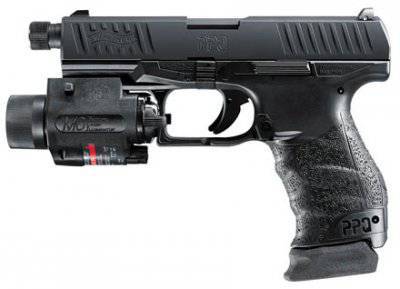 The combination of one of the most reliable automation schemes for a pistol, high-quality processing of weapon parts, a reasonable use of plastic and the ability to adjust the weapon to the characteristics of the shooter's palm made this pistol a really excellent model, which, in its short existence on the arms market, has become widespread not only in its homeland but also beyond. It is also important that the weapon has dimensions and weight quite suitable for concealed carrying, including daily. So the weight of the weapon is only 695 grams without cartridges in the version chambered for 9x19 cartridges, but if the weapon is designed for .40S & W ammunition, then the weight of the pistol will increase by only 10 grams, which creates a lot of questions that have no answers - a commercial secret. The length of the pistol in the version chambered for 9x19 cartridges is 180 millimeters, for .40S & W cartridges it is 184 millimeters, respectively, the barrel length is 102 millimeters and 106 millimeters. The thickness of the weapon is 34 millimeters, which is quite a lot, but provided that there are no elements protruding beyond the weapon itself, in practice this does not create any inconvenience. In both versions of the pistol, its height is 135 millimeters. There are also rumors that the weapon will be made for 9x21 IMI ammunition, but so far these are only rumors. The magazine capacity when using 9x19 rounds is 10 rounds (for the civilian market) 15 or 17 rounds. In the case of .40S & W cartridges, the magazine capacity can be 10 rounds (vice versa for the civilian market) 12 or 14 rounds.
The combination of one of the most reliable automation schemes for a pistol, high-quality processing of weapon parts, a reasonable use of plastic and the ability to adjust the weapon to the characteristics of the shooter's palm made this pistol a really excellent model, which, in its short existence on the arms market, has become widespread not only in its homeland but also beyond. It is also important that the weapon has dimensions and weight quite suitable for concealed carrying, including daily. So the weight of the weapon is only 695 grams without cartridges in the version chambered for 9x19 cartridges, but if the weapon is designed for .40S & W ammunition, then the weight of the pistol will increase by only 10 grams, which creates a lot of questions that have no answers - a commercial secret. The length of the pistol in the version chambered for 9x19 cartridges is 180 millimeters, for .40S & W cartridges it is 184 millimeters, respectively, the barrel length is 102 millimeters and 106 millimeters. The thickness of the weapon is 34 millimeters, which is quite a lot, but provided that there are no elements protruding beyond the weapon itself, in practice this does not create any inconvenience. In both versions of the pistol, its height is 135 millimeters. There are also rumors that the weapon will be made for 9x21 IMI ammunition, but so far these are only rumors. The magazine capacity when using 9x19 rounds is 10 rounds (for the civilian market) 15 or 17 rounds. In the case of .40S & W cartridges, the magazine capacity can be 10 rounds (vice versa for the civilian market) 12 or 14 rounds. Summarizing all the above, it is worth noting that such weapons as Walther PPQ Navy, if not unique in their kind, then quite rare, since only relatively recently the manufacturers of firearms returned to the understanding that the samples used on land and near water should differ from each other, to ensure their trouble-free operation, and even in order to save. True, there is another opinion - any weapon must be reliable and durable in a variety of operating conditions, but, unfortunately, the achievement of this will be too expensive. It would be interesting to draw a parallel with domestic samples of short-barreled weapons adapted for use near sea water, but unfortunately, there are no such ones. However, such a weapon can rather be attributed to a special one, and since now all forces are aimed at providing the army and the police with samples that are needed first and foremost, then it is not entirely correct to blame someone for “we don’t have such a thing”, even though that what was promised will appear in the near future, and only then it will be possible to think about other patterns.
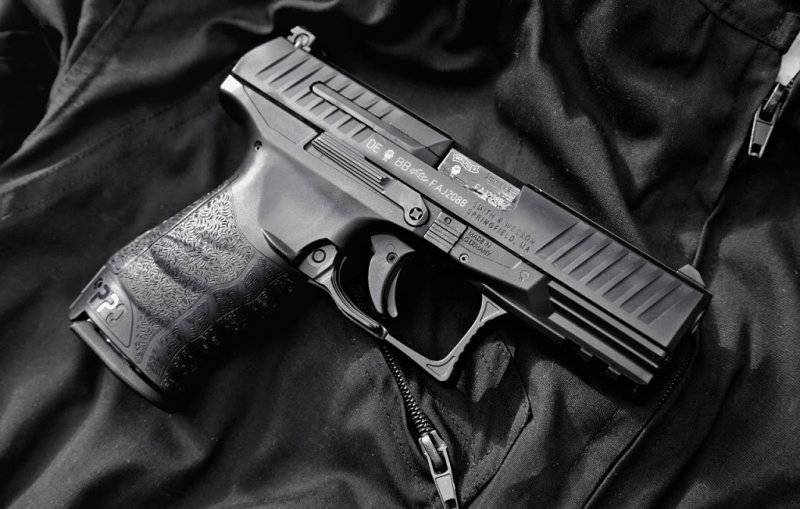
Information